- This page was last modified on 17 October 2025, at 10:18. Suggest an edit.
iMac facts for kids
This article is about IMAC (disambiguation)|IMAC. For other uses, see IMac (disambiguation).

Front face of an orange iMac (24-inch, M1, 2021)
|
|
| Developer | Apple Inc. |
|---|---|
| Product family | Macintosh |
| Release date | August 15, 1998 (G3) |
| Operating system | macOS |
| Related articles | Mac Mini, Mac Pro |
The iMac is a type of all-in-one desktop computer made by Apple Inc.. An all-in-one computer means that the screen and all the computer parts are built into one single unit. The iMac has been a main computer for everyday users since it first came out in August 1998. Over the years, it has changed its look and features many times.
The first iMac, called the iMac G3, looked like a colorful, see-through gumdrop or egg. It had a big, old-style TV screen (called a CRT monitor) inside a plastic case. Later, it got a smoother design where you could slide CDs or DVDs into a slot.
The next big change was the iMac G4. This one had a round base that held all the computer parts. A flat LCD screen was attached to the base with an arm that could move freely. After that, the iMac G5 and the Intel iMac put all the computer parts right behind the screen. This made them look very slim and modern, with the screen tilting up and down on a simple metal stand.
Later versions became even thinner, especially at the edges, and used cool materials like anodized aluminum and glass. These newer iMacs also got faster parts, like solid-state drives (SSDs) for storage, which are much quicker than older hard drives. Some even had a special "Fusion Drive" that mixed SSD and hard drive technology.
In 2014, Apple released a new 27-inch iMac with a super-sharp "Retina 5K" screen. This screen had a huge number of pixels (5120 × 2880), making images and videos look incredibly clear. A year later, a 21.5-inch iMac also got a "Retina 4K" screen. These high-resolution screens were great for people who work with photos and videos.
In 2017, Apple introduced the iMac Pro, a powerful version designed for professionals. It had strong Intel Xeon processors and came in a cool Space Gray color. The iMac Pro was stopped being made in 2021.
Then, in April 2021, Apple launched a new 24-inch iMac with their own powerful Apple M1 chip. This was a big change, as Apple started using its own chips instead of Intel's. These colorful iMacs come in seven bright colors and have a sharp 4.5K Retina display. They also have modern Thunderbolt 3/USB 4 and USB Type-C ports. In October 2023, even newer iMacs with the Apple M3 chip were announced, making them even faster.
Contents
How the iMac Started
When the iMac was first announced in 1998, it caused a lot of talk. Some people loved Apple's bold new design, while others weren't sure about the big changes to the Macintosh computers. At that time, Apple was having a tough time. Many people were choosing Windows PCs instead of Apple's computers. Some in the computer world even thought Apple might have to start selling computers with Windows.
The cool design of the iMac was created by Jonathan Ive, a famous designer at Apple.
The name "iMac" was thought up by Ken Segall, who worked for an advertising agency that helped Apple. He told Steve Jobs, Apple's co-founder, that he liked "iMac" better than "MacMan," which Jobs preferred. Segall explained that the "i" stood for "Internet," because the iMac was designed to make it easy to get online. But it also meant "individuality" and "innovation," showing that the computer was personal and new. After the iMac, Apple started using the "i" prefix for many other popular products, like the iPod, iPhone, and iPad.
The iMac was made to be super easy for people at home to connect to the internet. There was even a funny commercial called "Simplicity Shootout." In it, a seven-year-old boy and his dog set up an iMac much faster than a grown-up business student could set up an HP computer!
Important Updates Over Time
Around 2005, Apple decided to make a big change. They announced that their Macintosh computers would switch from using PowerPC processors to Intel processors. This was a huge deal! The first Macs with Intel chips, including the Intel iMac, came out in January 2006. Within nine months, Apple had switched all their computers to Intel. A cool benefit of this change was that Macs could now easily run Windows software too.
In July 2010, Apple updated the iMacs again with new Intel Core "i-series" processors. These made the computers much faster. They also introduced the "Apple Magic Trackpad," which is like the touchpad on a laptop, but for desktop computers.
In May 2011, iMacs got even more updates, including faster Intel "Sandy Bridge" processors and a better high-definition camera for video calls.
A major redesign happened in October 2012. The new iMacs became much thinner at the edges. To make them so thin, Apple removed the built-in CD/DVD drive (called a SuperDrive). These models also got faster processors and new storage options like the Apple Fusion Drive.
In October 2014, the 27-inch iMac got its amazing "Retina 5K" display. This was a big step forward for screen quality. It was perfect for people who needed to see every detail, like professional photographers and video editors. A year later, the 21.5-inch iMac also got a "Retina 4K" display.
In March 2019, Apple updated the iMacs with even newer and faster Intel Core i9 processors and better graphics. This made the 21.5-inch model up to 60% faster and the 27-inch model up to 2.4 times faster than previous versions! The outside look of the computer stayed the same.
On August 4, 2020, Apple refreshed the iMac models again. The smaller 21.5-inch model now came with fast SSD storage as standard. The 27-inch model got new Intel chips, a better camera, and improved microphones. It even had an option for special "nano-textured" glass to reduce glare.
Then, on April 20, 2021, Apple announced the completely redesigned 24-inch iMacs. These new models came in 7 vibrant colors, had updated cameras, and featured Apple's own powerful Apple M1 chip. This was a major change in how iMacs were built.
Most recently, on October 30, 2023, Apple announced updated iMac models that use the even more powerful Apple M3 chip.
How the iMac Changed Computers
The very first iMac was a "legacy-free PC." This means it was one of the first computers to get rid of older connections and parts. For example, it was the first Macintosh computer to have a USB port but no floppy disk drive. After the iMac, all Macs started including USB ports. This was a big deal because it meant that companies could make computer accessories that worked with both Windows PCs and Macs. Before, Mac users often had to buy special keyboards, mice, and printers just for Macs, which were often more expensive. USB made it easy for Mac users to choose from many different devices made for all computers. After the iMac, Apple continued to remove older ports and floppy drives from all its products.
The iMac also brought back the idea of an "all-in-one" computer, where everything is built into the screen. This idea started with Apple's original Macintosh computer. The success of the iMac helped Apple focus its more powerful computers (like the Power Macintosh) on high-end users. This strategy of having different products for everyday users and professionals continued with other Apple products, like the iBook laptop.
Apple's focus on design made its products stand out. The company avoided the boring beige colors that were common for PCs back then. Instead, the iMac came in fun, see-through, candy-like colors. This colorful design inspired other companies to make their products more stylish too. Later, Apple moved to using sleek anodized aluminum, glass, and white or black plastics, which also influenced the design of many other electronics.
Timeline of iMac models
| Timeline of iMac and eMac models (sorted by screen sizes) |
|---|
 |
For more detailed timelines, see the articles for each individual generation.
| Generation | Look | Screen Size | Processor | Storage | Release date | Discontinued |
|---|---|---|---|---|---|---|
| iMac G3 | 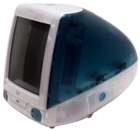 |
15″ CRT | PowerPC G3 | 4 GB to 60 GB | August 15, 1998 | March 2003 |
| iMac G4 | 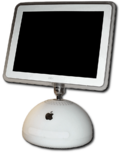 |
15″, 17″, or 20″ LCD | PowerPC G4 | 40 GB to 160 GB | January 2002 | July 2004 |
| iMac G5 | 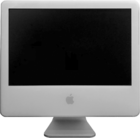 |
17″ or 20″ LCD | PowerPC G5 | 40 GB to 500 GB | August 31, 2004 | March 2006 |
| Polycarbonate Intel iMac | 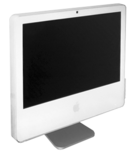 |
17″, 20″, or 24″ LCD | Intel Core Duo/Intel Core 2 Duo | 80 GB to 750 GB | January 2006 | August 2007 |
| Aluminum iMac | 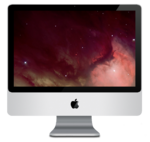 |
20″ or 24″ LCD | Intel Core 2 Duo | 250 GB to 1 TB | August 7, 2007 | August 2011 |
| Unibody iMac | 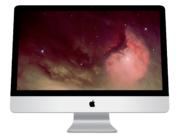 |
21.5" or 27" LED-LCD | Intel Core 2 Duo/i3/i5/i7 | 500 GB to 2 TB HDD or 256 GB SSD | October 20, 2009 | March 2013 |
| Slim Unibody iMac |  |
Intel Core i3/ i5/i7 | 1 TB to 3 TB HDD, Fusion Drive or 256 GB to 1 TB flash storage | November 30, 2012 (21.5"), January 2013 (27") | October 13, 2015 (27"), October 30, 2021 (21.5") | |
| Retina iMac |  |
Intel Core i3/i5/i7/i9 | 1 TB to 3 TB HDD, Fusion Drive or 256 GB to 2 TB flash storage | October 16, 2014 (27"), October 13, 2015 (21.5") | April 20, 2021 (21.5"), March 8, 2022 (27") | |
| iMac (Apple silicon) |  |
24" LED-LCD | Apple M series | 256 GB to 2 TB flash storage | April 20, 2021 | N/A |
See also
 In Spanish: IMac para niños
In Spanish: IMac para niños

